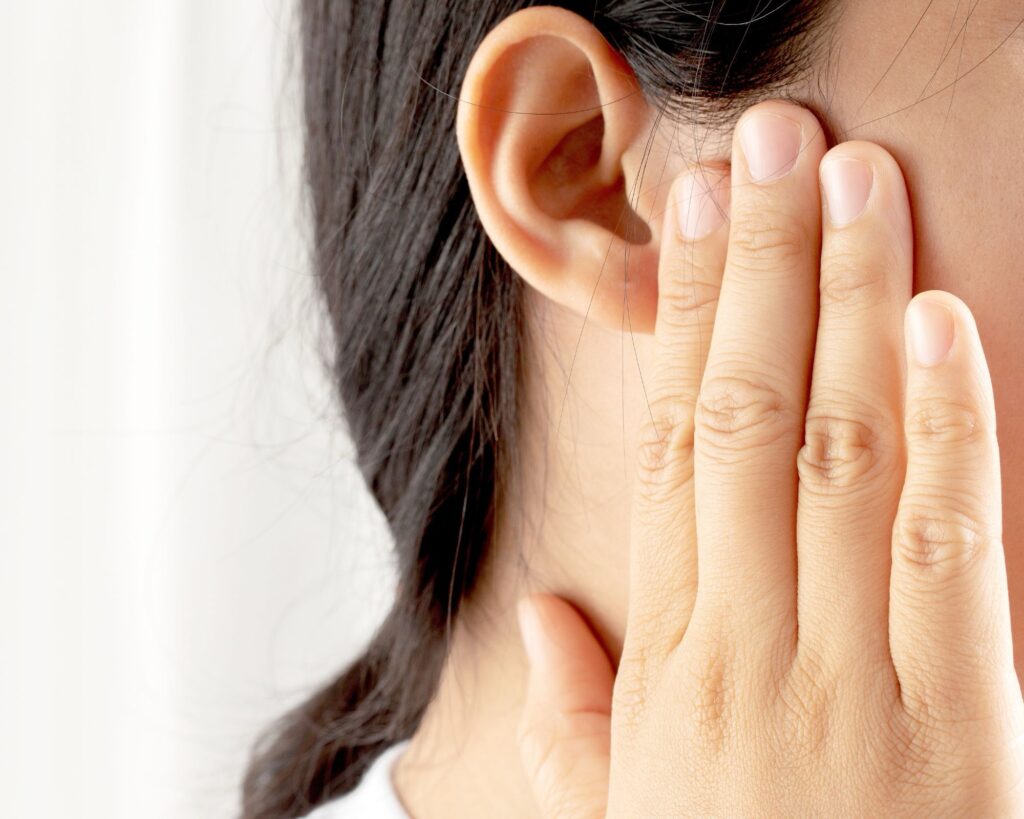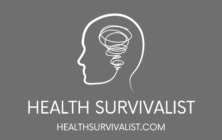Imagine this: you wake up one morning, and your jaw decides it’s going to audition for a solo in the orchestra of your body. It clicks, it pops, and frankly, it’s a little off-key. Welcome to my world—the world of someone living with Temporomandibular Disorder, or TMD as we’ve begrudgingly come to know it. It’s like having a mischievous gremlin living in your jaw, occasionally throwing a wrench in your day-to-day life with a symphony of symptoms that can range from mildly annoying to downright debilitating.

But here’s the twist in the plot: TMD is the villain with a disguise. It doesn’t just stop at the jaw. Oh no, it’s far more cunning than that. As someone who’s been living this TMD-adorned life, I’ve come to realize that it’s an intricate tale of mystery, confusion, and sometimes, sheer frustration. And in the spirit of shedding some light on this complex condition, I’m diving deep into the story of how TMD affects not just the jaw, but orchestrates a whole body experience that can often leave doctors puzzled and patients like me, well, a bit exasperated.
Is TMD Just About Jaw Pain, or Is There More to the Story?
“Is my jaw just overly dramatic, or is this a sign of something more?” That’s the question I found myself asking after the hundredth symphony of clicks and pops. It all started with what seemed like innocent jaw discomfort. A click here, a pop there—nothing a little rest couldn’t fix, right? Wrong. As it turns out, these were the opening notes to a much larger composition.
But let’s set the record straight: when we talk about TMD, we’re not just talking about a cranky jaw joint. No, it’s far more intricate. The jaw, known as the TMJ (temporomandibular joint), is just the beginning. TMD encompasses a whole range of disorders that can affect the muscles and ligaments that help this joint operate. So, yes, while my jaw does enjoy making its presence known, the effects of TMD ripple out, affecting areas I never would have connected to my jaw in the first place.
Living with TMD is a bit like being a detective in your own medical mystery, piecing together clues that at first glance, seem unrelated. Headaches, ear pain, even that weird sensation in my throat—all these symptoms I initially brushed off as unrelated nuisances turned out to be part of the TMD ensemble. It was only after diving into some thorough research, like the enlightening piece I found on identifying the root cause of pain, that I started to see the bigger picture.
So, as we venture further into the depths of TMD and its myriad of disguises, remember: this condition is more than just jaw pain. It’s a complex network of symptoms that requires a keen eye, a bit of humor, and a whole lot of patience to understand fully. Stay tuned as we explore just how deep the rabbit hole goes.

How Does TMD Turn My Head into a Battleground?
You might think the story of TMD begins and ends with the jaw. Oh, how I wish that were true! But as someone who’s become quite the connoisseur of this condition’s extensive repertoire, I’ve learned that it’s more like a domino effect, where the jaw is just the first piece to fall. The real plot twist? When TMD decides to wage war on your head, turning it into its very own battleground.
Let’s start with the headaches. Not just any headaches, mind you, but the kind that make you wonder if your head is actually trying to detach itself from your body. These aren’t your run-of-the-mill tensions headaches; they’re like a symphony of pain orchestrated by TMD, complete with a crescendo that could rival Beethoven’s Fifth. It’s a bewildering experience, feeling pain radiate from your jaw up through your skull, as if your head’s caught in a vice.
And then there’s the scalp sensitivity. Imagine a world where even a gentle breeze feels like a barrage of needles against your skin. Sounds dramatic? Perhaps. But when TMD is in the picture, what used to be a soothing touch now feels like an assault. The connection wasn’t obvious at first, but it became clear that when my jaw was at its worst, so was the sensitivity of my scalp.
Neck pain is another chapter in this saga. It’s like my neck decided to join the jaw in its rebellion against the rest of my body. The stiffness, the discomfort—it all seemed to tie back to the misadventures of my jaw. This revelation led me down a rabbit hole of research, seeking answers and, hopefully, some relief. It was during this quest that I came across a piece on nerve compression and its potential link to TMD. The article, “Understanding C5 to C6 Nerve Compression,” offered a glimpse into how interconnected our body’s systems truly are, suggesting that what happens in the jaw doesn’t stay in the jaw.
Living with TMD is akin to being a general overseeing a complex battlefield, where the enemy is an elusive condition that attacks on multiple fronts. The headaches, the scalp sensitivity, the neck pain—it all paints a picture of a condition that’s far more invasive than I ever imagined. And as I navigate this battleground, I’ve learned that understanding the enemy is the first step to claiming victory. So, armed with knowledge and a dash of humor to keep the spirits up, the fight continues.

Can TMD Really Affect My Ears and Hearing?
Imagine telling someone that your jaw pain is causing your ears to ring, and they look at you as if you just announced your candidacy for Martian Ambassador. Yes, my friends, TMD’s influence reaches even the seemingly unrelated parts of our bodies, including our ears. It’s like discovering your favorite sitcom has a crossover episode with a sci-fi show—unexpected, slightly confusing, but ultimately fascinating.
Tinnitus: The Uninvited Concert in My Ears
One of the most bizarre plot twists in my TMD saga has been developing tinnitus. For those unfamiliar, imagine hearing a constant ringing, buzzing, or hissing in your ears without any external source. It’s like having a private, never-ending concert playing just for you, except you never asked for tickets, and the band only knows one very annoying song. Initially, I couldn’t fathom how my jaw issues could lead to such auditory disturbances. Yet, here we are. TMD, in its enigmatic wisdom, can indeed affect the ears, leading to symptoms like tinnitus that add an extra layer of complexity to this condition.
Ear Pain and Fullness: More Than Just an Earache
Then there’s the ear pain and that peculiar sensation of fullness, almost as if my ears decided to go scuba diving without inviting the rest of me. At first, I was convinced I was dealing with an ear infection. But after multiple visits to the doctor and being told my ears looked as clear as a summer day, I had to look elsewhere for answers. It turns out that TMD can cause discomfort in the ears, too. The proximity of the TMJ to the ears means that any disorder in the joint can have a ripple effect, leading to symptoms that mimic ear infections.
Navigating the Soundscape of TMD
Living with these auditory symptoms has been an exercise in patience and adaptation. It’s a daily challenge to tune out the unwanted noise and discomfort. Yet, understanding that these ear-related issues are part of my TMD experience has been oddly comforting. It’s like finally getting the punchline to a joke that’s been going over your head for years.
In my quest for relief and understanding, I’ve stumbled upon resources that shed light on the complexity of TMD and its wide-reaching effects. Knowledge, as they say, is power, and in the battle against TMD, it’s my most trusted ally. So, to my fellow TMD warriors, know this: you’re not alone in hearing things that aren’t there or feeling like your ears are on an endless elevator ride. It’s just another episode in the bizarre sitcom that is life with TMD.

Why Do My Eyes and Throat Also Suffer From My Jaw’s Drama?
Living with TMD is like being in a mystery novel where your body is both the detective and the scene of the crime. You’d think the jaw, ears, head, and neck were enough for this condition to play with, but no—TMD is an overachiever. It also brings the eyes and throat into the mix, just in case life wasn’t interesting enough.
Eyes: The Unsuspecting Victims
Let’s talk about the eyes first. If someone had told me my jaw problems could make my eyes feel like they’d been on a Netflix binge-watch marathon without me, I would have laughed. But here we are, with eyes that are often red, sore, and as sensitive to light as a vampire at a beach party. This sensitivity and discomfort puzzled me until I realized that TMD’s reach knows no bounds. The strain and tension from TMD can lead to referred pain and discomfort in areas you wouldn’t immediately connect, like your eyes.
In my search for understanding and relief, I discovered a fantastic article, “Occipital Neuralgia: The Unseen Battle of Headaches and Heartaches,” which, while focusing on a different condition, provided insights into how nerve pain and sensitivity can affect areas beyond their origin. This reading helped me piece together why my eyes felt like they were under siege from my TMD.
Throat: Caught in the Crossfire
And then there’s the throat. Ever felt like you’re constantly trying to clear your throat or swallow something that’s not there? Welcome to another episode of “TMD’s Unexpected Surprises.” The throat discomfort and the sensation of a foreign object lodged in my throat were perplexing additions to my already extensive list of symptoms. It felt like my throat was caught in the crossfire of a battle it had no part in.
The link between TMD and throat symptoms lies in the complex network of muscles and nerves that span our head, neck, and jaw. When the TMJ is out of balance, it can trigger reactions in seemingly unrelated areas of our body, like the throat. For a deeper dive into how interconnected our body’s systems are, I found “Is it TMJ or Something Else? Identifying the Root Cause of Pain” to be a gold mine of information. This article (Is it TMJ or Something Else? Identifying the Root Cause of Pain) not only shed light on my throat symptoms but also reinforced the idea that in the world of TMD, everything is connected.
Connecting the Dots
So, here we are, navigating a condition that seems to have a domino effect on the body. The journey with TMD has taught me the importance of looking beyond the obvious symptoms and exploring how different parts of our body communicate in complex, sometimes bewildering ways. My advice to fellow TMD sufferers? Keep a sense of humor about the absurdity of it all, stay curious, and remember that knowledge is your ally. The more we understand about how TMD affects not just our jaws but our entire body, the better equipped we are to manage this condition and hopefully find some relief. Because, in the end, solving the mystery of TMD is a key step in regaining control over our health and well-being.
TMJ vs. TMD: What’s the Difference and Why Does It Matter?
Navigating the world of TMD feels like trying to solve a Rubik’s cube that changes colors every time you think you’re getting close. Just when I thought I had a handle on the jaw clicks and the eye twitches, I stumbled upon a whole new layer of complexity: the difference between TMJ and TMD. It’s like finding out the villain in your favorite show has a twin—equally troublesome but in slightly different ways.
Decoding the Acronyms
For the longest time, I thought TMJ and TMD were just different names for the same annoying guest living rent-free in my head. But, as it turns out, they’re more like siblings than twins. TMJ stands for temporomandibular joint—the very hinge that allows us to talk, chew, yawn, and, if you’re like me, occasionally sing terribly in the shower. It’s a critical component of our anatomy, involving bones, muscles, and ligaments all working in harmony.
TMD, on the other hand, stands for temporomandibular disorder. This is where the plot thickens. TMD encompasses a variety of conditions affecting the TMJ and the muscles and ligaments around it. It’s the difference between talking about a specific actor and the entire ensemble cast of a blockbuster movie.
Understanding this distinction was a lightbulb moment for me. It helped me communicate more effectively with my healthcare providers and navigate the sea of information (and misinformation) out there. For those looking to demystify this further, “Is it TMJ or Something Else? Identifying the Root Cause of Pain” is a treasure trove of clarity. It not only breaks down the difference between TMJ and TMD but also guides you through identifying the root causes of your pain.
Why the Distinction Matters
You might wonder, “Why bother with semantics?” Well, in the realm of TMD, words are like keys to a secret garden. They unlock doors to better understanding, more accurate diagnoses, and, ultimately, more effective treatments. Knowing whether you’re dealing with a joint issue (TMJ) or a broader disorder (TMD) can shape the path you take towards relief. It’s the difference between treating a single weed and addressing the whole garden’s ecosystem.
Armed with this knowledge, I felt empowered. It was as if I’d been given a map in a previously uncharted territory. This distinction also fosters better conversations with healthcare professionals, ensuring you’re both speaking the same language. And in a journey as complex and multifaceted as TMD, every bit of clarity helps.
So, fellow TMD adventurers, let’s not shy away from the nuances of our condition. Embracing the complexity of TMD, understanding the roles of the TMJ, and recognizing the symptoms are crucial steps in our journey towards wellness. And remember, amidst the twists and turns, keeping a sense of humor and an open mind can make all the difference. After all, life with TMD is nothing if not an adventure—one that we’re navigating together, one acronym at a time.

At-Home Treatment for Mild to Moderate TMD: A DIY Approach
Living with TMD is like being on a never-ending roller coaster—there are ups, downs, and unexpected turns. While professional medical advice is invaluable, sometimes the key to managing mild to moderate symptoms lies within the comforts of our own homes. As someone who’s ridden this roller coaster more times than I care to count, I’ve discovered a few at-home treatments that have become my go-to for those days when my TMD decides to remind me of its presence.
The Magic of Jaw Massagers
First on my list of home remedies is a jaw massager. Imagine a device that not only massages but also warms up the very muscles causing you so much grief. It sounds like a dream, right? Well, it’s very much a reality. The TMJ Relief Products Jaw Massager has been a game-changer for me. Its vibrating massage combined with a unique warming mode option works wonders on jaw and neck pain, stiffness, tension, and even headaches. It’s like having a personal masseuse dedicated solely to your jaw, ready to soothe away the pain at a moment’s notice. Plus, it’s ergonomically designed, which means it targets just the right spots to offer relief.
Natural Products for Nerve Pain and Toothache
Sometimes the pain takes a detour and decides to manifest as a toothache or nerve pain. That’s where natural products come in handy. I found the BestMade Natural Products Toothache & Nerve Pain In Jaw Bio23 to be particularly effective. These 300 pellets are designed for relief from trigeminal neuralgia, associated muscle spasms, painful cavities, tooth sensitivity, and pain after dental work. It’s like having a tiny army at your disposal, ready to combat the various facets of TMD-related discomfort, offering a natural, homeopathic alternative to managing symptoms.
The Immediate Relief of Jaw Release Tools
For those moments when the pain and tension feel unbearable, an immediate relief solution is a must-have. The Immediate TMJ Relief Product Jaw Release has been a staple in my TMD toolkit. This suboccipital release device doubles as a cervical neck pillow, serving as a neck stretcher and a neck & shoulder relaxer. It targets the tension headache right at its source, offering a form of relief that feels almost instant. It’s designed to release the jaw and alleviate the discomfort that comes with TMD, making it a versatile tool for anyone looking to manage their symptoms at home.

The Wide Spectrum of TMD Symptoms: A Personal Journey
As we dive deeper into the labyrinth that is Temporomandibular Disorder (TMD), it becomes evident that this condition doesn’t play favorites with the parts of our body it decides to affect. The initial jaw discomfort that sent me down this rabbit hole was just the tip of the iceberg. What I didn’t realize at the start of my journey was how vast the spectrum of TMD symptoms really is. It’s like opening a Pandora’s box of discomforts, each revealing a new layer of complexity to my condition.
The Head: Where the Pain Begins
The journey often begins in the head, with recurring headaches that feel like a tight band wrapped around my skull. The tension headaches and the peculiar sensation of shooting pain up the back of my head were my body’s early warning signs. On particularly challenging days, even my scalp decided to join the party, becoming so sensitive that a gentle brush of hair felt like walking through a field of nettles.
The Jaw: Ground Zero
The jaw, the epicenter of TMD, has its own tale of woe. The clicking and popping sounds became the soundtrack of my daily life, a constant reminder of the gremlin residing within my TMJ. Grating sounds accompanied by pain in the cheek muscles added layers to the symphony, while uncontrollable jaw movements danced to their own erratic rhythm.
Mouth and Teeth: The Unsung Victims
My mouth and teeth weren’t spared either. Discomfort became a constant companion, along with bruxism—grinding my teeth as if they were trying to start a fire. Jaw deviation made me look like I was always pondering a perplexing question, and my jaw locking shut or open at the most inopportune times added a slapstick element to my otherwise painful existence.
Eyes and Ears: The Silent Sufferers
The eyes, sensitive to sunlight, felt like they were allergic to joy, accompanied by bloodshot appearances that made sleepless nights evident. My ears decided not to be left out, with hissing, buzzing, or ringing creating a cacophony that drowned out the world’s melody. Decreased hearing, ear pain without infection, and a sensation of clogged, itchy ears added to the chorus, with vertigo and dizziness making every step an adventure.
The Throat: An Unexpected Participant
Finally, my throat chimed in, difficulty swallowing as if every meal was a puzzle to be solved. Frequent coughing or throat clearing became my new nervous habit, and the feeling of a foreign object lodged in my throat kept me on a constant lookout for the invisible intruder. A sore throat without infection was the cherry on top of this bewildering sundae of symptoms.
Living with TMD is like being the main character in a story where your body is the plot, filled with twists, turns, and a cast of symptoms that could rival any ensemble drama. Each symptom, from the head to the throat, plays a critical role in the narrative, making life with TMD a unique, albeit challenging, journey. As I navigate this complex condition, I’ve learned the importance of patience, humor, and resilience. TMD may have a wide spectrum of symptoms, but armed with knowledge and a supportive community, I’m learning to write my own script, one day at a time.
Navigating the world of TMD requires a combination of professional guidance, personal experimentation, and a healthy dose of patience. These at-home treatments have offered me a sense of empowerment in managing my TMD symptoms. They’re like loyal companions on this unpredictable journey, providing comfort and relief when I need it the most. Remember, what works for one person may not work for another, so it’s important to listen to your body and consult with healthcare professionals before trying new treatments. With the right tools and resources, managing mild to moderate TMD at home becomes a more attainable goal, allowing us to reclaim a sense of normalcy and well-being in our daily lives.
As an Amazon Associate we earn from qualifying purchases through some links in our articles.




